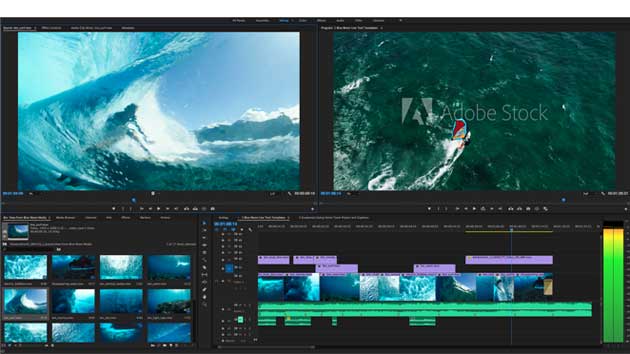New Team Projects Allow Premiere Pro, After Effects, Prelude Users to Access Shared Projects with Proxy-Enabled Workflow
Adobe announced new features that will be added to its Creative Cloud suite of applications by year's end, including additional VR tools in Premiere Pro and a new Team Projects workflow for cloud collaboration on Premiere, After Effects and Prelude projects. The new features and workflow will be highlighted at Adobe's IBC exhibit when the show kicks off later this week.
The marquee feature is Team Projects, which Adobe officials stressed is different from existing collaboration options because it does not require the set-up of a special Adobe Anywhere server in a facility. Instead, the service is managed in the cloud, allowing multiple users to sign into a shared team project with full versioning control and smart conflict resolution. "It works extremely well with our proxy technology," said Adobe Senior Director of Product Management Bill Roberts, referring to the new proxy workflow introduced earlier this year. Data is securely hosted in the cloud, and media files referenced in Team Projects can be local high-resolution source files or shared proxies.
For more on Team Projects, watch Adobe's pre-IBC video introducing the feature:
Roberts also described the advantages of embedding stock into the creative toolkit, noting that Adobe commissioned a study showing productivity improvements of up to 6x when Adobe Stock was used as an image source rather than a third party. The efficiency gains purportedly come from Adobe Stock's ability to send watermarked footage at HD or UHD resolution directly to Premiere projects (eliminating the need to scale low-res footage after it's licensed), the editor's ability to license footage from inside Premiere, and Adobe Stock's automatic application of non-destructive changes and effects to all instances of the clip. The "X" factor in such a study, of course, is whether an editor can consistently find the most appropriate content for any given project in the Adobe Stock library.
Premiere Pro
New in Premiere Pro is something Adobe calls "auto-aware VR," which is designed to detect the correct settings for stereo and mono VR footage (mono, stereo over/under or stereo left/right), along with the ability to publish to various social-media sites with integrated metadata for VR playback.
Premiere's caption support has also been expanded, with support for open captions as well as existing closed-caption options. In addition to text color, open captions can take on a new "edge color" for readability. Each new caption created inherits all of the properties of the first caption, and captions can be moved around and adjusted on the timeline.
After Effects
The big story with After Effects continues to be performance gains, as Adobe works to build better GPU processing into After Effects, especially for the most widely used effects. Thanks to a new video preview architecture, After Effects project manager Victoria Nece said during a demo for press, most raw footage now plays back in real-time without requiring a cache.
For 3D work. the Maxon Cinema 4D standard renderer, Cinerender, is now built into After Effects, allowing animators to work with text and shape layers in the AE timeline.

Character Animator
Nece also showed a new round-trip workflow for Character Animator, with additions and changes to elements of a puppet in Photoshop or Illustrator showing up live in Character Animator. Adobe has made it easier to share puppets with a new export function that packs all the different elements of a puppet into a single file. With an eye on helping newcomers to the program get up to speed with animation, Adobe has also added a Getting Started guide led by animated characters Andrew and Funkenstein.
Audition
Adobe's audio product manager, Durin Gleaves, said Audition's audio effect plug-ins are being updated for high-DPI awareness, and noted that some of the most popular Audition effects — including Adaptive Noise Reduction, Dynamics Processing, and Parametric Equalizer — are being ported over to Premiere Pro, where editors will be able to access them via a Clip FX Editor window.
And Adobe Media Encoder (AME) is getting some new moves as well, with the ability to stitch media together, either on camera ingest or when exporting. When you drag and drop media into the next version of AME, you will be asked if you want to add separate sources or stitch the clips together using the codec of the first clip in sequence. That should make it easier to create a reel of selects, or any other delivery that requires multiple clips be strung together, without actually building up the project on a Premiere timeline.
For more on the new Creative Cloud features, download Adobe's What's New datasheet [PDF].
Adobe Creative Cloud: adobe.com/creativecloud.html
Crafts: Audio Editing Post/Finishing VFX/Animation
Sections: Technology
Topics: New product adobe After Effects Audition character animator ibc 2016 media encoder premiere pro
Did you enjoy this article? Sign up to receive the StudioDaily Fix eletter containing the latest stories, including news, videos, interviews, reviews and more.











Leave a Reply